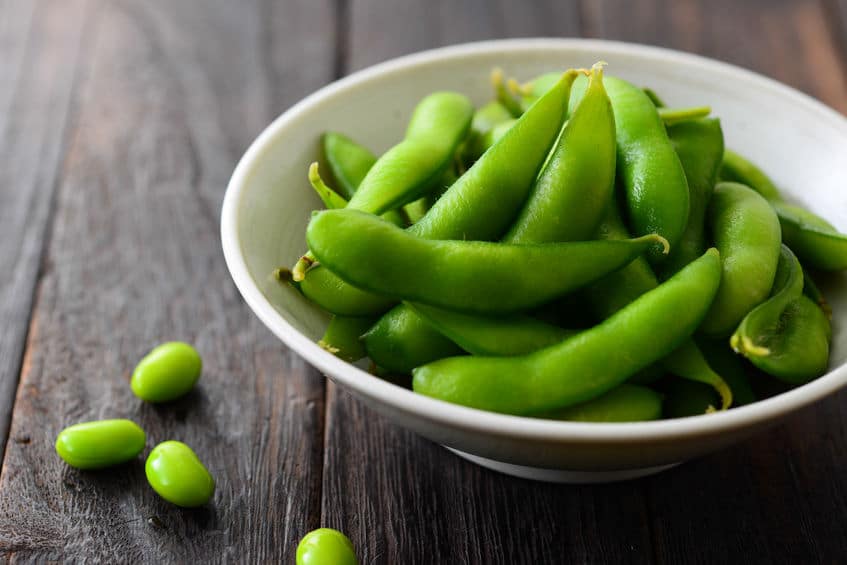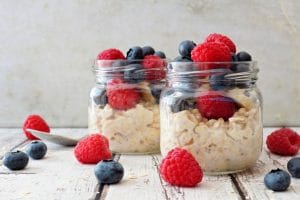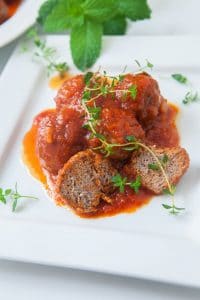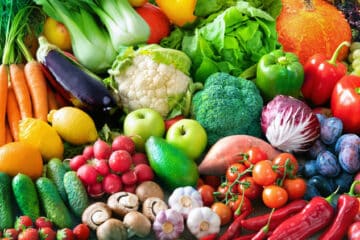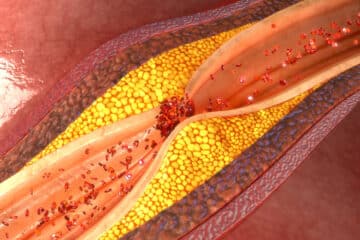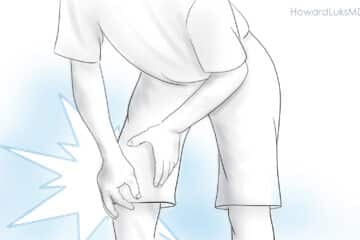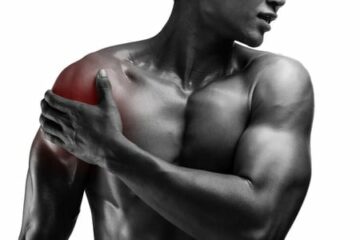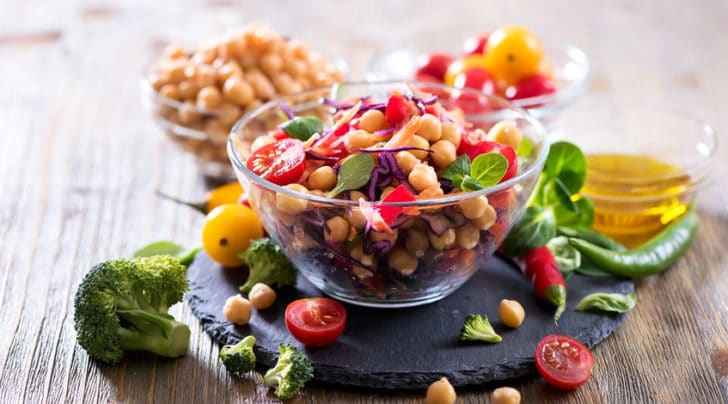
Whole food plant-based diets have helped many of our patients achieve health and weight goals that have eluded them for decades. None of those patients initially thought that the transition to a plant-based diet would be easy. Many of the patients in our office ask for more actionable assistance. We all need help on occasion to transition to a new lifestyle, especially if it involves a significant change to our diet. This next series of posts will focus on easing the burden when it comes to changing our diets in our efforts to improve our health, our weight, and our chance of living with a lower chronic disease burden.
How do we get enough protein on a whole food plant-based diet?
When I work with my patients to change their diet in an effort to be healthier, lose weight, avoid or prepare for surgery; a whole food plant-based (WFPB) diet is one of the options we discuss. Granted, any dietary change you choose to pursue needs to be sustainable for you. There is no one single perfect diet for everyone, despite all the noise online.
Some of us may prefer to eat meat, some may prefer a low fat, high carb diet. All diets that focus on whole foods and less of it have a chance of helping us become leaner and healthier. We have discussed how our metabolism affects our joints and our tendons. A whole food diet is an important first step in repairing our body’s metabolism.
Two concerns frequently arise with people who want to try a WFPB diet. The first is where will the fats come from? There are many ways to get healthy, essential fats into your diet on a WFPB diet. This will be covered in-depth in a later post. The second issue that many have is where will I get my protein from? This post will focus on your protein choices when you are considering moving to a whole food plant-based diet.
Dietary changes require that you know what your “macros’ are. Macros include Protein, Carbs, and Fats. WFPB diets can be low fat, high fat (keto), high carb, or low carb. Again, which you pursue is up to you, and your palate. This needs to be sustainable to be effective over the long term.
How much protein do I need?
We need enough protein to enable our bodies to manufacture muscle protein. Muscles are constantly being broken down and rebuilt. It’s a delicate balance. To maintain net positive muscle protein synthesis, we need to maintain an adequate dietary intake of protein.
Protein is composed of amino acids. Amino acids are the building blocks of muscle protein. The most important amino acid with respect to muscle protein synthesis is Leucine.
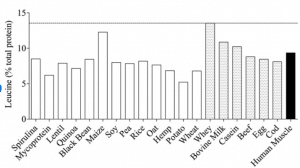
https://www.researchgate.net/profile/Stephan_Van_Vliet
The precise amount of protein we need to eat each day can vary. Younger folks likely need 0.8-1 gram of protein per kilogram of bodyweight. Those of you who exercise heavily will need up to 1.5-1.6 grams of protein per kilogram of bodyweight. As we age, we need to consume more protein to minimize the risk of sarcopenia, or age-related muscle loss. Therefore, even if you do not exercise, taking in at least 1.5 grams of protein per kilogram of body weight is important after the age of 55.
Those formulas translate into protein intake of 60-80 grams/day for an average adult male, and 50-60 grams/day of protein for an average adult female.
Can we get enough protein from plants?
The short answer is yes, you can get all your dietary protein needs from plants. There are a number of amino acids, which are the building blocks of protein that our body cannot synthesize. They are referred to as essential amino acids. Although plant protein may have some disadvantages when compared to animal or whey protein, you can clearly get all your protein needs with a whole-food, plant-based diet.
The Top 8 sources of protein for a whole food plant-based diet
The foods listed here can be used for meal preparation. When snacking, nuts and seeds can also provide protein too. This list is for those of you trying to come up with ideas for protein sources for your daily meals.
Keep in mind what your daily protein needs are. If you know how many meals you will be eating then you can determine how much protein source you need to consider using. Mix it up, these all have different textures and different tastes.
1. Tempeh (20g of protein/100g serving)
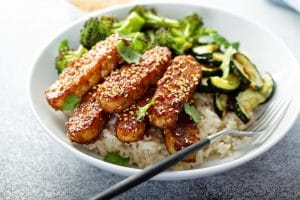
Utilizing 100g as a serving size, your macros will be:
11.4g Fat / 7.6g Carbs / 19.9g Protein / 195 calories
Tempeh is also rich in copper, manganese, iron, VitB2, B6, and Zinc.
2. Tofu (13.3g of protein/100g serving)
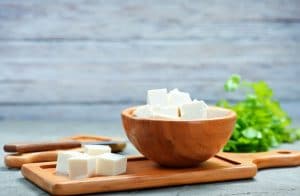
Utilizing 100g as a serving size, your macros will be:
7g Fat / 0.9g Carbs / 13g Protein / 110 calories
Tofu is also a good source of Manganese, calcium, iron, selenium, and Vit B5.
 3. Oats (13.2g of protein/100g serving)
3. Oats (13.2g of protein/100g serving)
Utilizing 100gm as a serving size, your macros will be:
6.5g Fat / 57.6g Carbs / 13.2g Protein / 370 calories
Steel-cut oats, the least processed form of oats are my favorite. These are not for folks on a low carb diet. The more the oat is processed, the more fiber content you lose. That fiber content is important. So that means you need to be willing to cook your oats for 15-20 minutes. There are gluten-free Oat brands available for those who are sensitive to gluten or those who have celiac.
Oats are also a good source of Manganese, Iron, selenium, Vit B1, Magnesium, Fiber, Vit B5 and Copper.
 4. Seitan (75g of protein/100g serving)
4. Seitan (75g of protein/100g serving)
Seitan is a product made from gluten, thus should be avoided by those who are sensitive to gluten. The easiest way to make seitan is to hydrate vital wheat gluten powder. It forms a dough. When cooked it has a great texture which sets it apart from tofu. Seitan is one of the most protein-dense plant-based foods available.
Utilizing 100 grams as a serving size, your macros will be:
1.9g Fat / 13g Carbs / 75g Protein / 370 calories.
Seitan is also rich in Selenium, iron, phosphorus, and copper.
5. Lupini Beans (26g of protein in 1 cup).
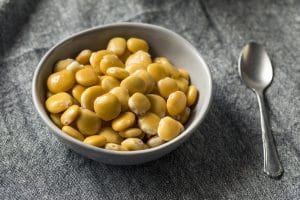
Utilizing a one cup size, Lupini beans have a macro of 198 calories, 26 grams of protein, 16 grams of carbohydrates, 5 grams of fat, and 5 grams of fiber.
Lupini beans contain generous amounts of manganese, copper, magnesium, phosphorus, potassium, zinc, folate and vitamin A.
6. Edamame (12.4g of protein/100gram serving)
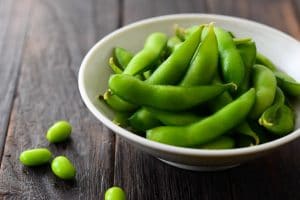
In a 100 gram serving the macros are: 6.4g Fat / 6.7g Carbs / 12.4g Protein / 141 calories
Edamame also contains Iron, Folate, Vit B1, Vit C, Potassium and Omega 6 fatty acids.
7. Lentils (9g of protein/100 grams )
The macros of lentils are as follows: 0.4g Fat / 14.3g Carbs / 9g Protein / 116 calories per 100 grams.
Lentils are too high in carbs for people on keto / LCHF diets. But lentils should be a staple in a whole food plant-based non-keto diet. There are different colors and types of lentils. Each one has a more unique flavor and purpose. Some stand up better to cooking more so than others.
Lentils are rich in folate, iron, copper, manganese, fiber and Vit B1 and B5
8. Quinoa: (8g of protein per cup)
The macros of a cup quinoa are as follows: 222 calories /4 grams of fat / 5 grams of fiber / 8 grams of protein / 40 grams of carbs.
Quinoa is one of the most popular seed sources of protein in the world. Quinoa is gluten-free.. and it is very high in soluble fiber. It also contains manganese, magnesium, folate, copper, iron, and thiamine.
Transitioning to a whole food plant-based diet is not easy… but the effort is worth it. A WFPB has helped many achieve weight loss and a significant improvement in their metabolic health. These changes may have allowed some to put off their knee replacement surgery. For others, being in better health lessens the risks associated with surgery and eases their recovery.
As we have written about before… your metabolic health affects your joints and tendons. The sooner you realize this… the better off you will be.
